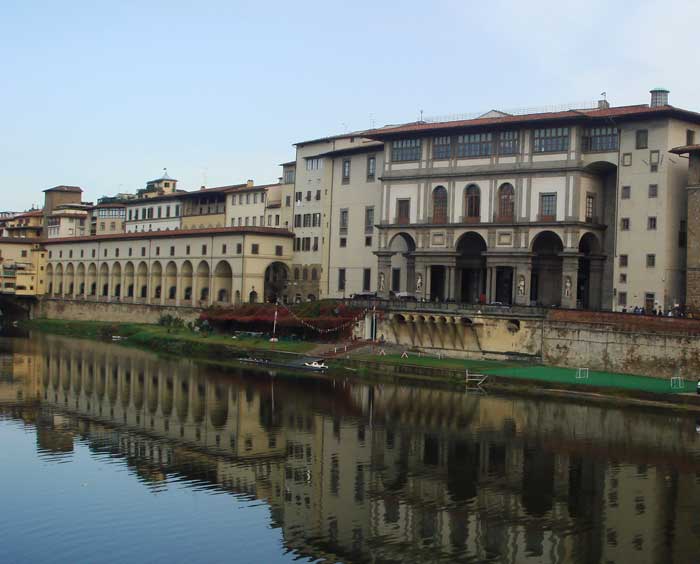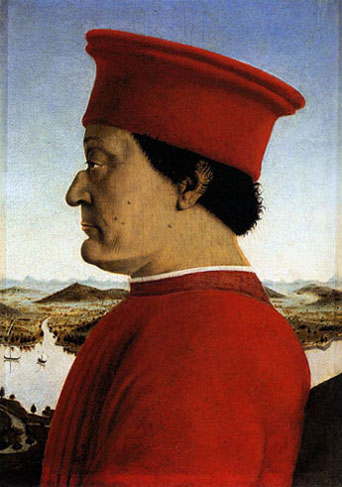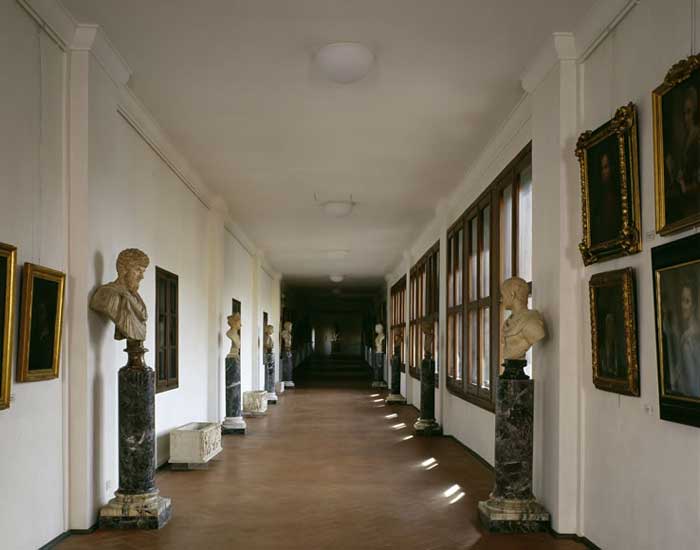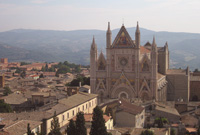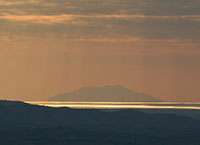| |
|
The Uffizi Gallery (Italian: Galleria degli Uffizi) is one of the oldest and most famous art museums of the Western world.
Building of the palace was begun by Giorgio Vasari in 1560 for Cosimo I de' Medici as the offices for the Florentine magistrates — hence the name "uffizi" ("offices"). Construction was continued to Vasari's design by Alfonso Parigi and Bernardo Buontalenti and ended in 1581. The cortile (internal courtyard) is so long and narrow, and open to the Arno River at its far end through a Doric screen that articulates the space without blocking it, that architectural historians[2] treat it as the first regularized streetscape of Europe. Vasari, a painter as well as architect, emphasized the perspective length by the matching facades' continuous roof cornices, and unbroken cornices between storeys and the three continuous steps on which the palace-fronts stand. The niches in the piers that alternate with columns were filled with sculptures of famous artists in the 19th century.
The Palazzo degli Uffizi brought together under one roof the administrative offices, the Tribunal and the state archive (Archivio di Stato). The project that was planned by Cosimo I, Grand Duke of Tuscany to arrange that prime works of art in the Medici collections on the piano nobile was effected by Francesco I de' Medici, who commissioned from Buontalenti the famous Tribuna degli Uffizi that united a selection of the outstanding masterpieces in the collection in an ensemble that was a star attraction of the Grand Tour.
Grand Duke Francesco I de' Medici was a man of profound and obsessive passions. The Uffizi galleries, which he established, were one, Bianca Cappello (1548-1587), his mistress, and afterwards, the second wife, was the other.
Over the years, further parts of the palace evolved into a display place for many of the paintings and sculpture collected by the Medici family or commissioned by them. According to Vasari, who was not only the architect of the Uffizi but also the author of Lives of the Artists, published in 1550 and 1568, artists such as Leonardo da Vinci and Michelangelo gathered at the Uffizi "for beauty, for work and for recreation."[3]
After the house of Medici was extinguished, the art treasures remained in Florence by terms of the famous Patto di famiglia negotiated by Anna Maria Luisa, the last Medici heiress; it formed one of the first modern museums. The gallery had been open to visitors by request since the sixteenth century, and in 1765 it was officially opened to the public.
Because of its huge collection, some of its works have in the past been transferred to other museums in Florence — for example, some famous statues, to the Bargello. A project is currently underway to expand the museum's exhibition space, allow ing public viewing of many artworks that have usually been in storage.
In 1993, a car bomb exploded in Via dei Georgofili and damaged parts of the palace, killing five people. The most severe damage was to the Niobe room, the classical sculptures and neoclassical interior of which have been restored, although its frescoes were damaged beyond repair. The identity of the bomber or bombers are unknown, although it was almost certainly attributable to the Sicilian Mafia who were engaged in a period of terrorism at that time.
Today, the Uffizi is one of the most popular tourist attractions of Florence. In high season (particularly in July), waiting times can be up to five hours. Visitors who reserve a ticket in advance have a substantially shorter wait.
|

|
Plano Uffizi [2]
|
Galleria degli Uffizi
Postal & visiting address: Piazzale degli Uffizi, I-50122 Florence (Firenze)
Web | www.uffizi.firenze.it
Museum Hours
Open Tuesday through Sunday, 8:15am – 6:50pm
Closed: every Monday, January 1, May 1, December 25
|
|
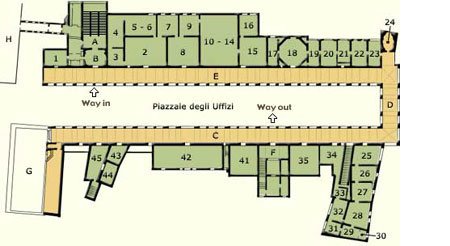 Floor Plan of the Galleria Degli Uffizi, second floor Floor Plan of the Galleria Degli Uffizi, second floor
Sale degli Stranieri
Thanks to the great passion for art of the Medici family, today the Uffizi owns one of the greatest collection of the most important painters from the Netherlands.
After many restoration works, these smaller rooms, finally display the works by foreign artists from the 16th up to the 18th century: French, Spanish, Dutch, and Flemish artists.
The blue rooms or “Rooms of the Foreigners” are indeed characterized by an intense blue colour on the walls; a great novelty, in contrast with the white-grey colour of the upstairs Renaissance Gallery following the Vasari tradition.
Amongst the protagonists of the Spanish room you’ll find Goya e Velazquez; in the Dutch and Flemish rooms you can admire the great works by Rembrandt, Van Dyck, Rubens, Pieter van Slingelandt , and Jan van der Heyden among the others.
The blue “Sale degli Stranieri” can be reached from the Gallery getting down to the Scala di Ponente, a new staircase by Adolfo Natalini, that is part of the project, still in progress, to renovate the museum.
|
S E C O N D F L O O R
Room 1 - Archaeological room
Room 2 - Giotto and 13th Century
Room 3 - Senese Painting 14th Century
Room 4 - Florentine Painting 14th Century
Room 5/6 - International Gothic
Room 7 - Early Renaissance
Room 8 - Filippo Lippi
Room 9 - Antonio del Pollaiolo
Room 10/14 - Botticelli
Room 15 - Leonardo
Room 16 - Geographic Maps room
Room 17 - Ermafrodito
Room 18 - The Tribune
Room 19 - Perugino and Signorelli
Room 20 - Dürer and German Artists
Room 21 - Giambellino and Giorgione
Room 22 - Flemish and German Painting
Room 23 - CorreggioRoom 24 - Miniatures room
Room 25 - Michelangelo and Florentine Artists
Room 26 - Raffaello and Andrea del Sarto
Room 27 - Pontormo and Rosso Fiorentino
Room 28 - Tiziano and Sebastiano del Piombo
Room 29 - Parmigianino and Dosso Dossi
Room 30 - Emilian Painting
Room 31 - Veronese
Room 32 - Tintoretto
Room 33 - Room 33 - 16th Century Painting
Room 34 - Lombard School
Room 35 - Barocci
Room 41 - Rubens
Room 42 - Niobe
Room 43 - Caravaggio
Room 44 - Rembrandt
Room 45 - XVIII Century
|
The blue rooms dedicated to foreign artists
|
|
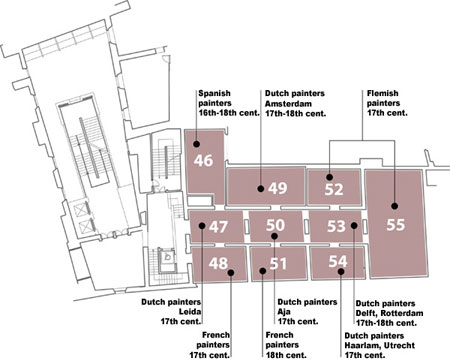
After the deep blue of the rooms devoted to the foreigners, and with a view to respecting Vasari's two- tone colour scheme – the grey of the pietra serena and the white of the walls – for these new rooms devoted to the Florentine sixteenth century the colour chosen to visually characterise the itinerary, and the panels concealing part of the service plants, is the crimson of Medici memory.
|
F I R S T F L O O R
46 Spanish Painters, 16th-18th centuries
47 Dutch painters, Leida 17th century
48 French painters, 17th century
49 Dustch painters, Amsterdam 17th-18th centuries
50 Dutch painters, Aja 17th century
51 French painters, 18th century
52 Flemish painters, 17th century
53 Dutch painters, Delft, Rotterdam, 17th-18th centuries
54 Dutch painters, Haarlem, Utrecht, 17th century
55 Flemish painters, 17th century
|
The red rooms dedicated to the Cinquecento
|
|
The first two rooms, adjacent to Loggia dei Lanzi (one displaying Hellenistic marbles and the other three monochromes by Andrea del Sarto), at once represent the cultural link and anticipate the painting of the 'modern manner' embodied in the works displayed in the series of seven rooms that follows. These include paintings by Andrea del Sarto, Rosso Fiorentino, Pontormo, Bronzino and Raphael. In addition to these seven rooms are two others frescoed by Luigi Ademollo, the layout of which will be finalised in the near future.
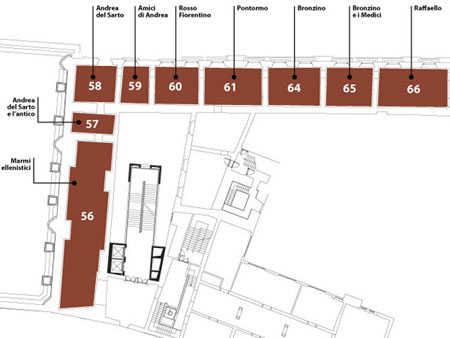
The blue rooms dedicated to foreign artists (20-12-2011)
The red rooms dedicated to the Cinquecento
|
56 Hellenistic marbles
57 Andrea del Sarto & Ancients
58 Andrea del Sarto
59 Friends of Andrea
60 Rosso Fiorentino
61 Pontormo
64 Bronzino
65 Bronzino & the Medici
66 Raphael
|
|
|
|
| |
|
If we follow the natural layout of the rooms, we enter the large rooms that display the great altarpieces of Cimabue, Giotto, Duccio di Buoninsegna, the first remarkable examples of western painting, followed by the remarkable works of 14th century Siennese artists, such as Simone Martini and the brothers Piero and Ambrogio Lorenzetti and the pupils of Giotto. The following rooms display some fine examples of the lnternational Gothic style: the Adoration of the Magi by Gentile da Fabriano and another one by Lorenzo Monaco, before actually reaching the most important rooms of the museum that are dedicated to the early Renaissance. These rooms exhibit works by Masaccio, Paolo Uccello, Domenico Veneziano, Piero della Francesca, Beato Angelico, followed by the elegant Madonnas of Filippo Lippi, by the precious panels of the brothers Piero and Antonio del Pollaiolo to end with the mythological allegories and religious paintings of Sandro Botticelli.
Of this artist, the museum preserves perhaps the finest colloction of works, comprising the Birth of Venus, the Primavera, the Magnificat and Pomegranate Madonnas.
It is then the turn of Perugino, Signorelli, Piero di Cosimo and Leonardo da Vinci; the latter is represented both with the painting the Baptism of Christ painted together with Verrocchio, the large Adoration of the Magi and his early work the Annunciation.
The following rooms (from n. 18 to n. 23) are the oldest of the museum; it is well worth stopping to admire the Tribuna that originally contained the most precious works and objects. Today it displays also a series of portraits of the Medici family by Agnolo Bronzino, in addition to the oldest sculpture piece of the museum, the Medici Venus. The following rooms, originally used as armouries, offer again more paintings by Renaissance artists, both Italian - with works by Bellini, Giorgione, Mantegna and Correggio - and foreign artists with paintings by Dürer, Cranach, Memling.
Continuing along the rooms on the western side of the Gallery, it is possible to admire more 16th century masterpieces, starting trom the "Tondo Doni" by Michelangelo, the Madonna of the goldfinch by Raphael and the Venus of Urbin and Flora by Titian.
Even the section dedicated to Mannerism is lavish and comprises works by Pontormo, Rosso Fiorentino, Bronzino down to Parmigianino (Madonna with the lonq neck) and famous Venetian artists such as Sebastiano del Piombo, Veronese, Tintoretto, and Lombard ones like Savoldo and Moroni. Until not so long ago the visit to the gallery ended with some l7th century works by famous Italian (Caravaggio, Carracci) and Dutch (Rembrandt) artists.
|
|
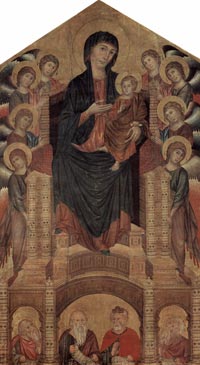
Santa Trinita Madonna, Painted around 1280 for the high altar of the church of Santa Trinità. At the Uffizi since 1919.
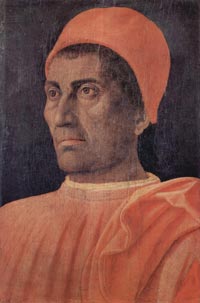 Mantegna, Andrea, Portrait of Mantegna, Andrea, Portrait of
Cardinal Carlo De' Medici, 1466
|
|
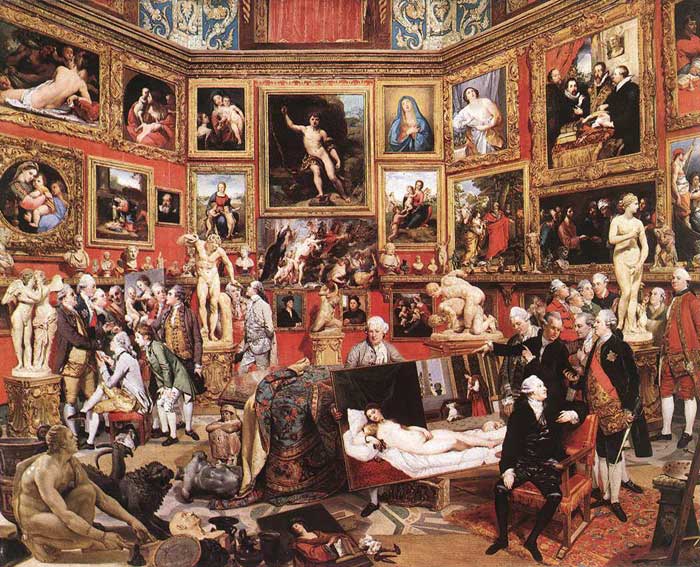 |
Johann Zoffany, The Tribuna of the Uffizi, (1772-78)
|
The Tribuna of the Uffizi (1772–8) by Johann Zoffany is a painting of the north-east section of the Tribuna room. This room was constructed in the latter part of the 16th century to house the treasures of the Medici collection. The room is still one of the major focal points of the Uffizi collection.
Johann Zoffany was a German born painter who had become a successful in London. One of his principal patrons was the Royal family. Queen Charlotte had sent Zoffany to Florence where he had agreed to paint the Tribuna of the Uffizi. In the summer of 1772 Zoffany left London for Florence with the commission from Queen Charlotte to paint ‘the Florence Gallery’.
The group of men in the center of the painting are arranged around the Venus of Urbino by Titian. This Venetian work finished in 1538 played a major role in establishing the female nude as one of the central subject matters in Western painting since the Renaissance.
|
Room 5/6 - International Gothic
|
By the end of the 14th century, the fusion of Italian and Northern European art had led to the development of an International Gothic style. This style is noted for extreme linearity, giving the effect of elegance and refinement, and attention to decorative detail. Also characteristic of the style are attention to surface design and decorative detail; bright, sharply contrasting colors; and elongated figures often portrayed in slightly fantastic costumes. Paintings executed with graceful draftsmanship adorned portable panels or altarpieces designed for churches and commissioned by wealthy patrons for private chapels.
Many of the works in the International Gothic style are devoted to secular themes.
The beautiful Annunciation by Simone Martini and Lippo Memmi is one of the greatest examples of Sienese Gothic paintings and is placed at the Uffizi.
|
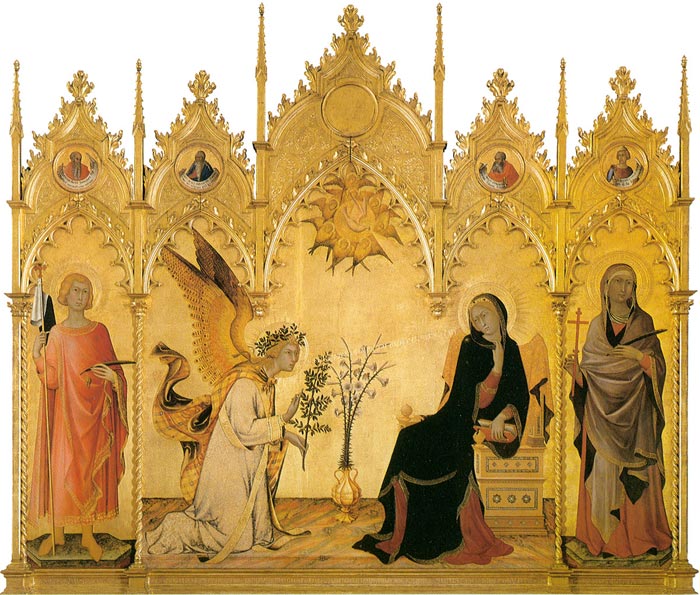 |
Simone Martini, The Annunciation and the Two Saints, 1333, tempera on wood, 265 x 305 cm, Galleria degli Uffizi, Florence
|
The Annunciation is one of the most widely painted themes in Christian iconography. The scene is based on a book from the Gospel of Luke. The Archangel Gabriel goes to the Virgin Mary to announce that she has been chosen as the Mother of God. In that precise moment, the Virgin Mary is reading, and the angel had caught her by surprise. However, soon thereafter, she accepts to give birth to Jesus Christ. There are several iconographical elements that reappear: the presence of fleur-de-lis (symbol of the virginity of Mary), the white dove (symbol of the Holy Spirit) and the book (symbolizing the spiritual value of Mary).
All of these elements are present in Simone Martini’s version, however he does include novelties in the painting. He adds an atmosphere reminiscent of the royal court, giving an almost profane sense to the scene. Martini depicts the Virgin Mary in the exact moment that she is perplexed after the announcement made by Gabriel. Moreover, she a very realistic, earthly and seductive woman, who looks more like a grand dame than the Virgin Mary. There is not much space in the scene either. The spatial limit posed by Martini gives the scene a more intimate feeling. The movements of the Virgin Mary are simultaneous, giving her an extraordinary, naturalistic look.
|
Art in Tuscany | Simone Martini | The Annunciation
· Rooms 5-6: International Gothic – Paintings List
· Giovanni di Paolo: Madonna and Child with Saints
· Florentine Master: Thebaid
· Agnolo Gaddi: Crucifixion
· Lorenzo Monaco and Cosimo Rosselli: Adoration of the Magi
· Gentile da Fabriano: Adoration of the Magi
· Lorenzo Monaco: Coronation of the Virgin
· Gentile da Fabriano: Four Saints from the Quaratesi Polyptych
· Unknown Artist from Northen Italy: Saint Benedict Exorcizes a Monk
· Unknown Artist from Northen Italy: Saint Benedict Blesses the Paisoned Wine
· Unknown Artist from Northen Italy: Saint Banedict Repairs the Nurse's Tray
· Tommaso di Cristoforo Fini da Panicale called Masolino: Madonna of Humility
Rooms 5-6: International Gothic | Detailed Paintings List of this Room
|
|

Gentile da Fabriano, Adoration of the Magi (detail), (1423), Galleria degli Uffizi, Florence
|
Room 7 - Early Renaissance
|
Room is dedicated to early Renaissance. On the left wall the famous Battle of San Romolo by Paolo Uccello (1456). On the easel, the famous Portraits of Federico da Montefeltro Duke of Urbino and his Wife Battista Sforza by Piero della Francesca (1456-66).
|
The Battle of San Romano by Paolo Uccello
The Battle of San Romano is just the central panel of a large triptych painted by Paolo Uccello approximately in 1438, now dispersed and divided between the Uffizi, the National Gallery in London and the Louvre in Paris.
The cycle depicts three events occurred during the Battle of San Romano that took place in 1432 between Florence and Siena and that marked the glorious victory of Florence. The work was commissioned by the wealthy Bartolini family but in 1492 it was included already in the inventory of Lorenzo de’ Medici, known as “the Magnificent”.
|
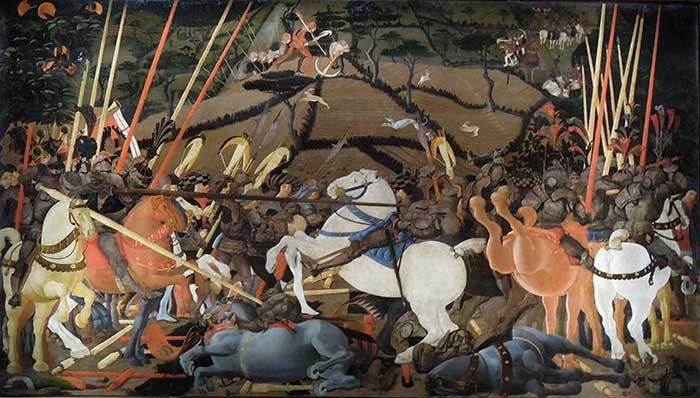 |
Paolo Ucello, The Battle of San Romano, c. 1438–1440, egg tempera with walnut oil and linseed oil on poplra, Galleria degli Uffizi, Florence
|
Portraits of Federico da Montefeltro Duke of Urbino and his Wife Battista Sforza
On the easel, the famous Portraits of Federico da Montefeltro Duke of Urbino and his Wife Battista Sforza by Piero della Francesca (1456-66). On the front the two panels show profile portraits of Federico da Montefeltro, Duke of Urbino, and his wife, Battista Sforza. The reverse shows allegorical representations of their virtues. To be dated around 1465/70. At the Uffizi since 1773.
Itinerary in Tuscany| In the footsteps of Piero della Francesca
|
|
Portraits of Federico da Montefeltro and His Wife Battista Sforza (1465-66), Panel, 47 x 33 cm (each), Galleria degli Uffizi, Firenze
|
On the back, the Triumphs of the Duke and Duchess. He represents the subjects on marble terraces against a midday sun that hits the distant landscape. A creation rendered with an extremely poetic geometric abstraction, exalted in the fullness of the light, against a vast lanscape. Here the Flemish suggestions are surpassed in a completely new synthetic vision. With the inheritance of Vittoria della Rovere, wife of Ferdinand II Medici, the work passed over to the Uffizi in 1631, together with other art treasures.
On the opposite wall, St. Anne Enthroned with the Madonna and Child, work done in collaboration by Masolino and Masaccio, who shows a style already full and mature, despite his young age. On the right, Madonna Enthroned with Saints (1445), by Domenico Veneziano, formerly in the church of St. Lucia de' Mongoli, a work which vibrates with the color rendered luminous by the daylight that covens the spaces and palpitates in the figures painted with intense humanity. On the next wall, Madonna and Child, by Beato Angelico, Coronation of the Virgin, also by Beato Angelico, which can be admiredin all its magnificence only in Florence in the Convent of St. Mark. In both these works Beato Angelico succeeded in unting miniaturistic detail with the monumentality of the composition, already in full Reinassance style.
Painted probably around 1424 for the church of Sant'Ambrogio. Masolino painted Saint Anne and all the angels except for the top righthand one, painted by Masaccio who is also responsible for the Madonna and Child. At the Uffizi since 1919.
Piero della Francesca | Diptych Portrait of Federico da Montefeltro, Duke of Urbino (1472) and Diptych Portrait of Battista Sforza (1472)
Art in Tuscany | Masaccio and Masolino da Panicale,The Madonna and Child with Saint Anne
· Room 7: Early Renaissance – Paintings List
· Fra Angelico: Coronation of the Virgin
· Piero della Francesca: The Duke and Duches of Urbino
· Paolo Uccello: The Battle of San Romano
· Masolino and Masaccio: Madonna and Child with Saint Anne
· Domenico Veneziano: Saint Lucia dei Magnoli Altapiece
· Fra Angelico: Madonna and Child
Room 7: Early Renaissance – Detailed Paintings List
|
|
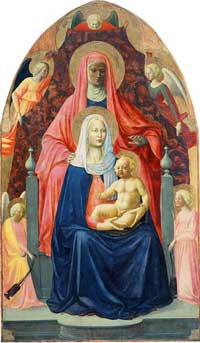 Masaccio and Masolino da Panicale, The Madonna and Child with Saint Anne , 1424, tempera on panel, 175 x 103 cm, Galleria degli Uffizi, Florence Masaccio and Masolino da Panicale, The Madonna and Child with Saint Anne , 1424, tempera on panel, 175 x 103 cm, Galleria degli Uffizi, Florence |
Room 10/14 - Botticelli
|
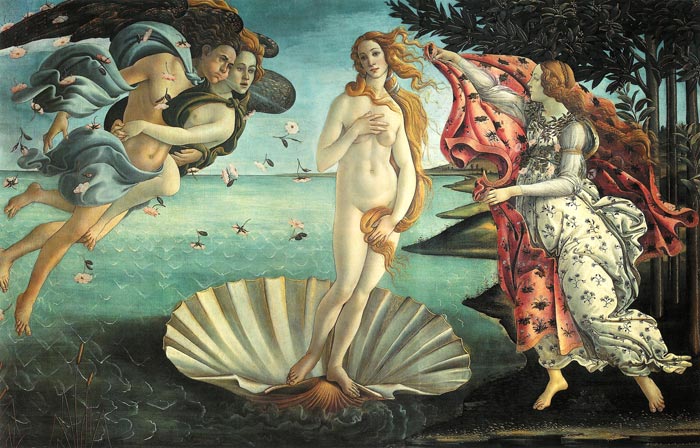 |
Sandro Botticelli, The Birth of Venus, c. 1486, Uffizi Gallery, Florence
|
This large room is one of the most famous of the Uffizi, being displayed some of the most iconic allegorical works of the Italian Renaissance and some of the greatest works by Sandro Botticelli.
Among the many paintings, two have entered the collective visual imagination as the essence of the Renaissance: The Birth of Venus (c. 1484) and The Spring (c. 1482). These masterpieces are permeated by mysterious associations not completely deciphered yet. The identities of the characters in the Primavera are clear enough: on the right Zephyrus, god of the west wind, chases the nymph Cloris, who is then transfigured into Flora, the pregnant goddess of spring; Venus stands in the centre, to the side of the three Graces, who are targeted by Cupid; on the left Mercury wards off the clouds of winter. What this all means, however, has occupied scholars for decades, but the consensus seems to be that it shows the triumph of Venus, with the Graces as the physical embodiment of her beauty and Flora the symbol of her fruitfulness.
|
The Birth of Venus is less obscure: it takes as its source the myth that the goddess emerged from the sea after it had been impregnated by the castration of Uranus, an allegory for the creation of beauty through the mingling of the spirit (Uranus) and the physical world.
· Room 10-14: The Botticelli Room – Paintings List
· Rogier van der Weyden: Entombment
· Sandro Filipepi called Botticelli: Saint Augustine in his Study
· Filippino Lippi: Portrait of an Old Man
· Sandro Filipepi called Botticelli: Portrait of a Young Man with a Medal
The sitter, who has been variously identified as the artist's brother or as the artist himself, holds a medal portraying Cosimo the Elder, which was coined after 1464. The portrait dates from 1474/5. At the Uffizi since 1704.
· Sandro Filipepi called Botticelli: Calumny
· Filippino Lippi: Adoration of the Magi
· Filippino Lippi: Pala degli Otto
· Sandro Filipepi called Botticelli: Madonna of the Pomegranate
· Sandro Filipepi called Botticelli: Annunciation
· Sandro Filipepi called Botticelli: Magnificat Madonna
· Domenico Bigordi called Ghirlandaio: Adoration of the Magi
· Filippino Lippi: Self-portrait (?)
· Lorenzo di Credi: Venus
· Hugo van der Goes: Portinari Triptych
· Filippino Lippi: Adoration of the Child
· Sandro Filipepi called Botticelli: Madonna and Child
· Filippino Lippi: Allegory
· Sandro Filipepi called Botticelli: Spring (Primavera)
· Sandro Filipepi called Botticelli: San Barnaba Altarpiece
· Domenico Bigordi called Ghirlandaio: Stories from the Lives of Saints and Man of Sorrows
· Domenico Bigordi called Ghirlandaio: Madonna and Child with Predella with Pietà and Saints.
· Sandro Filipepi called Botticelli: Stories from the Lives of Saints and Man of Sorrows
· Lorenzo di Credi: Adoration of the Shepherds
· Filippino Lippi: Saint Gerome
· Sandro Filipepi called Botticelli: Birth of Venus
· Domenico Bigordi called Ghirlandaio: Madonna Enthroned with Saints
· Sandro Filipepi called Botticelli: Adoration of the Magi
Painted for the church of Santa Maria Novella around 1475, it contains the portraits of several members of the Medici family. AT the Uffizi since 1796.
· Sandro Filipepi called Botticelli: Pallas and the Centaur
The Botticelli Room – Detailed Paintings List
Wikimedia Commons | Paintings in the Uffizi Gallery - Room 10-14, Botticelli's
|
|
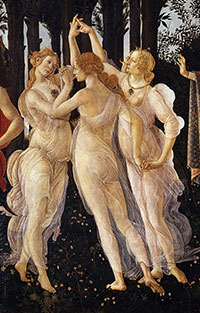
Sandro Botticelli, Spring (Primavera)(detail)
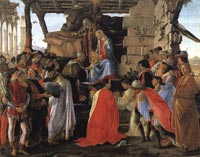
Adorazione dei Magi
|
Room 15 - Leonardo
|
| |
Room 15 is very famous thanks to some masterpieces by young Leonardo da Vinci, painted before he moved to Milan in 1482 in the service of Duke Ludovico il Moro.
The distinctive touch of Leonardo da Vinci appears first in the Baptism of Christ (c.1470-1475) by his master Verrocchio. Even if it was painted mainly by Verrocchio, we can notice Leonardo’s touch in the young angel on the left and in the landscape.
In the same room, in addition to the works of Leonardo, there are also important works by other famous masters active during the late XV and early XVI century: Perugino (worth to admire his beautiful Pietà, c.1493-1494), Luca Signorelli, Lorenzo di Credi and Piero di Cosimo.
· Room 15: The Leonardo Room – Paintings List
|
· Piero di Cosimo: Perseus Frees Andromeda
· Leonardo da Vinci: Adoration of the Magi
· Lorenzo di Credi: Annunciation
· Leonardo da Vinci: Annunciation
· Luca Signorelli: Allegory of Fertility and Abundance
· Piero di Cosimo: Incarnation
· Andrea di Cione called Verrocchio: Baptism of Christ
· Francesco Botticini: The Three Archangels
· Pietro Vannucci called Perugino: Pietà
· Pietro Vannucci called Perugino: Agony in the Garden
· Luca Signorelli: Crucifix with Maria Magdalen
· Luca Signorelli: The Trinity, the Virgin and Saints
· Luca Signorelli: Last Supper, Agory in the Garden, Flagellation.
Detailed Paintings List of this Room
|
|
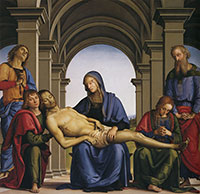
Pietro Perugino, Pietà, Uffizi Gallery, Florence |
Room 64-65 - Bronzino
|
Agnolo di Cosimo, known as Bronzino, was undoubtedly one of the most cultivated exponents of Florentine Mannerism, whose activity was chiefly focussed on painting portraits of the Medicean Court.
Main portrait painter of the Medici family, this room contains specimens of the courtly, celebratory art of the artist. His portraits of Cosimo and Eleonora, among other figures of the Duke’s court, revealed a delicate coldness and almost aloof presence in his subjects. This defined Bronzino’s unemotional, yet stylish portrait technique.
The Portrait of Eleonora da Toledo with her son Giovanni is perhaps one of the greatest results of the artist's career, in which the eye rests on the sumptuousness and sophistication of the vestments and pureness of the complexions.
Among the other portraits are those of Giovanni de' Medici as a boy and Bia daughter of Cosimo I, in which one notes the distinctive characteristic of the painter to linger on the preciousness and details of the vestments and jewellery, with secure drawn form and abstract background.
|
|
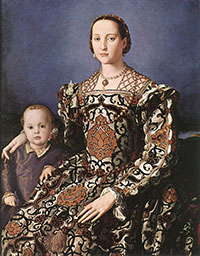
Eleonora of Toledo with her son Giovanni de' Medici; 1544-45, oil on wood, 115 x 96 cm, Galleria degli Uffizi, Florence
|
|
On the ground floor the remains of the old Romanesque church of S. Pier Scheraggio partly destroyed by Vasari to build the Uffizi, have been recently restored; the frescoes of Famous Men' by Andrea del Castagno (1421-c. 1457) are exhibited here.
The fresco Dante Alighieri is part of the series of famous people that Andrea painted around 1450 in the loggia of Villa Carducci at Legnaia, near Florence ; they were removed around the middle of the last century and acquired by the Florentine Galleries.
Andrea del Castagno was widely acclaimed, however, for this series of Famous Men and Women produced for the Villa Carducci Pandalfini at Legnaia. The Legnaia cycle consists of nine portrayals (three Florentine military commanders, three famous women and three Tuscan poets), placed inside painted niches made to look like monumental marble recesses, separated by pilasters. On one of the room's short walls, the figures of Adam and Eve were painted.
The Uffizi buildings also house other important collections: the Contini Bonacossi Collection and the Collection of Prints and Drawings (Gabinetto Disegni).
At the beginning of the Twentieth century Count Alessandro Contini Bonacossi returned to Italy from Spain with his wife Vittoria and two children Augusto Alessandro and Vittorina. While in Spain he was highly successful in the antique trade and began what was to become one of the largest private collections of paintings, furniture, ceramics and statues. Upon his death, his children Alessandro and Vittorina bequeathed the central part of this exceptional collection to the State.
Today the Contini Bonacossi donation is displayed in ten rooms which are part of the Uffizi Gallery, though not directly connected to the main building. Visits are only by appointment.
|
|
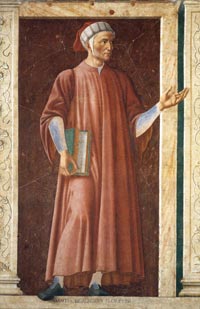
Andrea del Castagno, Dante Alighieri, from the Cycle of Famous Men and Women, c. 1450. Detached fresco. 247 x 153 cm. Galleria degli Uffizi, Firenze. The picture shows one of the three Tuscan poets represented in the cycle. |
|
|
|
The Vasari Corridor
|
The visit to the Gallery could ideally end with another section: that is the famous Vasari Corridor, built by Vasari in 1565. The Corridor joins the Uffizi to Palazzo Vecchio, crosses the river Arno above Ponte Vecchio and is connected with Palazzo Pitti and the Boboli Gardens. Recently restored after the explosion of the bomb, the corridor now displays over seven hundred works comprising mamly the Important group of Self-portraits (from Andrea del Sarto to Marc Chagall). At present the corridor can be visited only by groups and by reserving the visit ahead.
|
|
In its Uffizi section the Vasari Corridor is used to exhibit the museum's famous collection of self-portraits
|
The Vasari Corridor was built in 5 months by order of Grand Duke Cosimo I de' Medici in 1564, to the design of Giorgio Vasari. It was commissioned in connection with the marriage of Cosimo's son, Francesco, with Johanna of Austria. The idea of an enclosed passageway was motivated by the Grand Duke's desire to move freely between his residence and the government palace, when, like most monarchs of the period, he felt insecure in public, in his case especially because he had replaced the Republic of Florence. The meat market of Ponte Vecchio was moved to avoid its smell reaching into the passage, its place being taken by the goldsmith shops that still occupy the bridge.
The Corridor was restored and reopened to the public in 1973 but can only be visited by appointment or to groups (the entrance is between rooms 25 and 34). Apart from the fact that the visitor can enjoy some magnificent and little-known views over the city from its round windows, the passageway contains over 1000 paintings, all dating from the 17th and 18th centuries, as well as the important collection of Self-portraits by some of the most famous masters of painting of the 16th to the 20th century.
This collection, unique in the world, was created by Cardinal Leopoldo de' Medici in the mid 17th century, a golden century for collections, and receives regular additions to this day. It displays self-portraits by Andrea del Sarto, Beccafumi, Bernini, Annibale Carracci, Guido Reni, Salvator Rosa, Rubens, Canova, Hayez, Corot, Ingres, Delacroix, Ensor and many others.The Corridor was built in 1564 by Giorgio Vasari in only five
months at the time of the wedding between Francesco I de' Medici and Giovanna of Austria; it served to link up the Pitti Palace, where the Grand Duke resided, with the Uffizi (or offices) where he worked. |
|
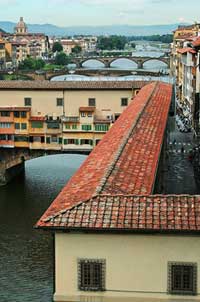
The West Corridor of the Gallery, heads towards the Arno and then, raised up by huge arches, follows the river as far as the Ponte Vecchio, which it crosses by passing on top of the shops. |
| |
|
|
|
|
| |
|
 |
|
|
[1] In early August 2007, Florence was caught with a large rainstorm, and the Gallery was partially flooded, with water leaking through the ceiling, and the visitors had to be evacuated. There was a much more significant flood in 1966 which damaged most of the art collections in Florence severely, including the Uffizi.
The Kunsthistorisches Institut in Florence | The Flood of 1966
This dramatic event in the recent history of the city of Florence is portrayed in the online exhibition based on the comprehensive inventory of the photo library. Significant is that the photographs are much more than mere witnesses of the catastrophe. The photographic eye reveals unexpected perspectives of the devastation and losses. The stunned amazement and horror of the observer of the destructive forces of nature are expressed in these photographic works.
The photographer Ivo Bazzechi, who took most of the photographs exhibited here, recorded his impressions during the flood. The photographs record the situation during and after the catastrophe, in which immense damage was inflicted on streets, plazas, buildings, and works of art. In particular, the primary aim of the collection of photographs shown here is to highlight the damage and destruction inflicted on works of art, such as those in the Santa Maria Novella and Santa Croce churches, or inflicted on individual works, such as the almost completely destroyed Crucifix by Cimabue. The symbol of the devastating effects of the flood is the almost complete destruction of the huge Crucifix by Cimabue. The crucifix, painted in distemper on wood (around 1272) by one of the most significant painters of the 13th century, had lost the majority of its layer of paint. The first action taken was to move this work of art from the former Santa Croce refectory to the Limonaia in the Giardino di Boboli. In 1976, the Crucifix underwent a major restoration, during which it was possible to conserve the remains of the layer of paint.
The exhibition in the Kunsthistorisches Institut documents the flood’s immediate aftermath and the ramifications for the city and its artistic treasures. The first section depicts the damage and destruction suffered by the works of art themselves. The second selection illustrates the devastation of the city and its streets, alleys, squares and houses.
The majority of the exhibition’s 80 photographs, taken by Ivo Bazzechi, date from the dramatic days following the flood.
[2] Image by Hmaglione10 - Own work, CC BY-SA 4.0, Link
|
|
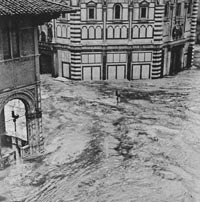 View onto the Baptistery and the Loggia del Bigallo (Photographer Bazzechi) View onto the Baptistery and the Loggia del Bigallo (Photographer Bazzechi)

L'alluvione del 4 novembre 1966. Piazzale degli Uffizi, Gallerie degli Uffizi
|
 |
Gallerie degli Uffizi, Piazzale degli Uffizi, veduta verso l'Arno
|
[3] The Tribuna of the Uffizi (1772–8) by Johann Zoffany is a painting of the north-east section of the Tribuna room in the Uffizi. The Tribuna of the Uffizi is an octagonal room in the Uffizi gallery, designed by Bernardo Buontalenti for Francesco I de' Medici in the late 1580s. The most important antiquities and High Renaissance and Bolognese paintings from the Medici collection were and still are displayed here. In 1737 the Grand Duchess Anna Maria Luisa de' Medici ceded the collection to the Tuscan government, and by the 1770s the Uffizi (and in particular the Tribuna) was the hub for Grand Tourists visiting Florence.
Johann Zoffany's famous painting of it (commissioned by Queen Charlotte of the United Kingdom in 1772) portrays the north-east section, but varies the arrangement and brings in works not normally displayed in the Tribuna (e.g., Raphael’s Madonna della Sedia). Admiring the works of art are connoisseurs, diplomats and visitors to Florence, all identifiable.
Johann Zoffany was a German born painter who had become a successful in London. One of his principal patrons was the Royal family. Queen Charlotte had sent Zoffany to Florence where he had agreed to paint the Tribuna of the Uffizi. Zoffany left London for Florence with a commission from Queen Charlotte to paint ‘the Florence Gallery’. (Neither she nor her husband George III ever visited Italy in person.) Still working on the painting late in 1777, he only finally returned to England in 1779.
Zoffany has varied the arrangement of the artworks and introduced others from elsewhere in the Medici collection. He gained special privileges, with the help of George, 3rd Earl Cowper (1738-80), and Sir Horace Mann, 1st Baronet (1706-86), such as having seven paintings, including Raphael’s Madonna della Sedia, temporarily brought in from the Pitti Palace so that he could paint them in situ in the Tribuna. In thanks Zoffany included a portrait of Cowper looking at his recent acquisition, Raphael's Niccolini-Cowper Madonna (Cowper hoped to sell it on to George III - it is now in the Washington National Gallery of Art), with Zoffany holding it (to the left of the Dancing Faun).
The unframed Samian Sibyl on the floor was acquired for the Medici collection in 1777 - it was a workshop copy of the pendant to Guercino’s Libyan Sibyl, recently bought by George III, and may be intended as a compliment to him.
All the connoisseurs, diplomats and visitors to Florence portrayed are identifiable, making the painting a combination of the British eighteenth-century conversation piece or informal group portrait genre, with that of the predominantly Flemish seventeenth-century tradition of gallery views and wunderkammers. However, this inclusion of so many recognisable portraits led to criticism at the time by Zoffany's royal patrons, and by Horace Walpole, who called it ‘a flock of travelling boys, and one does not know nor care whom’.)
|
|
Grand Duke Francesco I de' Medici was a man of profound and obsessive passions. The Uffizi galleries, which he established, were one, Bianca Cappello (1548-1587), his mistress, and afterwards, the second wife, was the other.
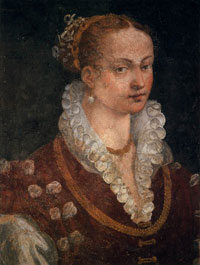
Alessandro allori, Portrait of Bianca Cappello, Second Wife of Francesco I de' Medici, c. 1580, fresco, Galleria degli Uffizi, Firenze
|
|
|
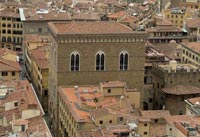 |
|
 |
Orvieto, Duomo |
|
Florence, Orsanmichele |
|
Siena, Duomo |
| |
|
|
|
|

Official website | www.uffizi.firenze.it
Museum expansion project official website - The New Uffizi | www.nuoviuffizi.it
The project for the "New Uffizi gallery", which is already underway, will significantly alter the original layout of the museum, doubling the exhibition rooms. Thanks to this new arrangement it will be possible to distribute more evenly works that are now concentrated in a few rooms, exhibit paintings that are now stored in the gallery's warehouses or include whole collections that had to be displayed elsewhere, like the Contini Bonacossi collection (see below), due to lack of space. It is too early to foresee the exact layout of the new gallery, althongh it is certain that the collections will be arranged in chronological order and by schools.
Bibliography
Damien Wigny, Au coeur de Florence : Itinéraires, monuments, lectures, 1990
|
|
This article incorporates material from the Wikipedia article Uffizi published under the GNU Free Documentation License.
Wikimedia Commons has media related to Uffizi and Galleria degli Uffizi
|

Tuscan Holiday houses | Podere Santa Pia
|
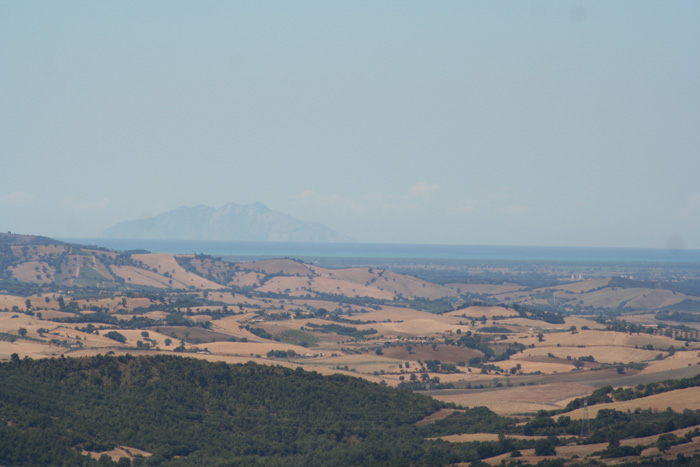 |
Podere Santa Pia, with a stunning view over the Maremma and Montecristo
|
| |
|
|
|
|
|
|
|
|
|
|
Podere Santa Pia |
|
Podere Santa Pia, garden |
|
Montecristo, view from Santa Pia
|
 |
 |
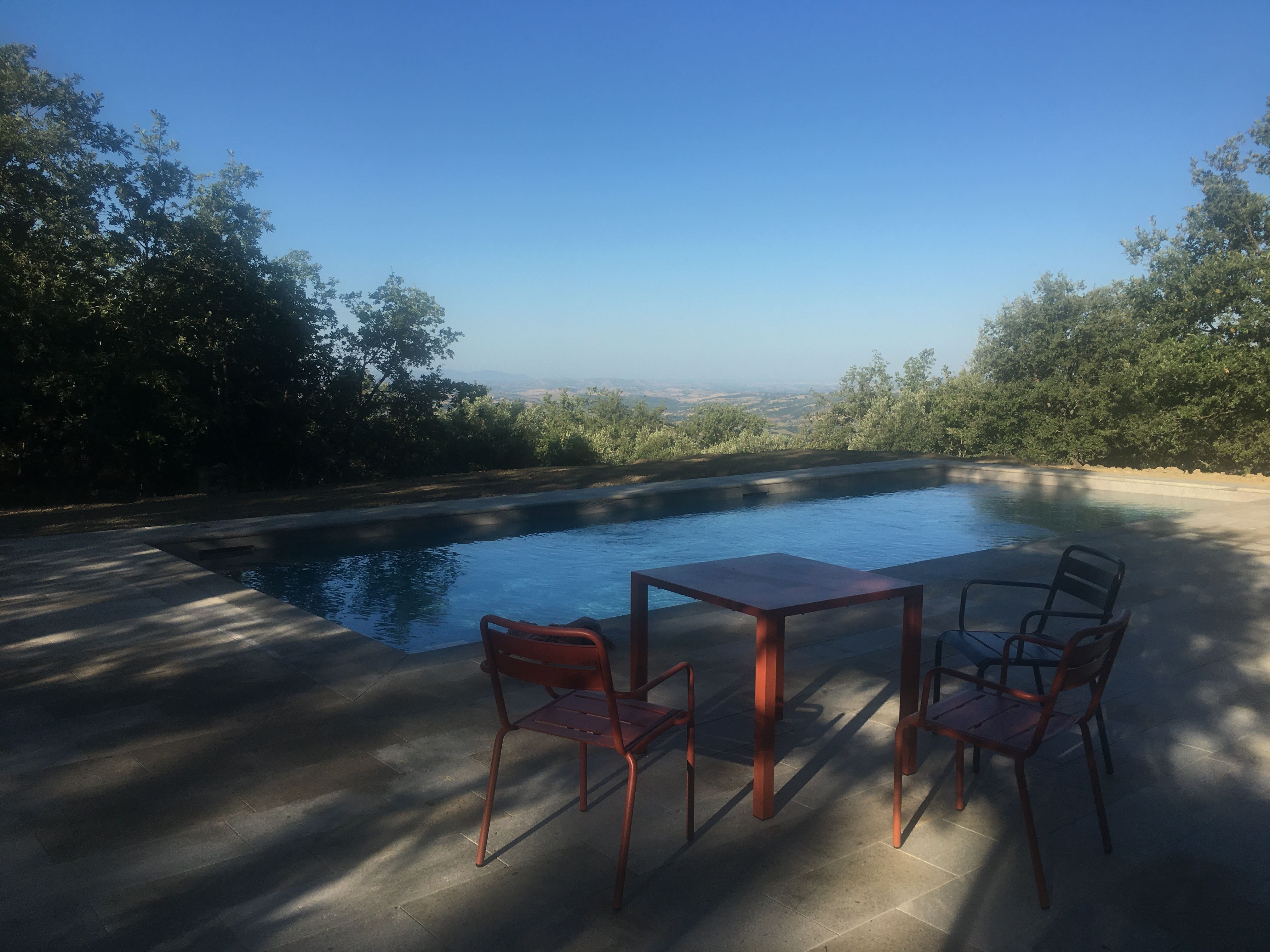 |
|
 |
Podere Santa Pia, mystic holiday home in the heart of the Tuscan Maremma
|
|
Early morning light at the private swimming pool at Podere Santa Pia
|
|
A beautiful early evening by the pool, in the resplendent Tuscan sun, time takes on a languid quality
|
| |
|
|
|
|
 |
|
|
|
|
Walking in Tuscany | Florence | A Walk Around the Uffizi Gallery
|
|
|
The Uffizi Gallery contains some of the most important and greatest art collections in the world. It is also the world’s oldest museum.
Built in the shape of a horseshoe extending from Piazza della Signoria to the Arno River and linked by a bridge over the street with Palazzo Vecchio, the Uffizi were intended to house the administrative offices (uffizi) of the Grand Duchy. From the beginning, however, the Medici set aside a few rooms on the third floor to house the finest works of their collections. The Gallery was subsequently enriched by various members of the Medici family. Two centuries later, in 1737, the palace and their collection were left to the city by Anna Maria Luisa, the last Medici heir, and today houses one of the world's great art galleries.
The best way to explore this city is to walk around the thousand little streets that give form to the incomparable and charming historic center. The Uffizi tour leads you through the most important streets, palaces and churches around the Uffizi Gallery. |
|
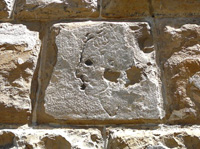 Michelangelo, L'Importuno |
| |
|
|
View Larger Map |
|
|
![]()
![]()
![]()
![]()
![]()

